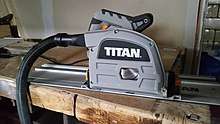Track saw
Track saws (often referred to as plunge saws or plunge-cut saws) are a type of hand-held circular saw which slides on a guide rail during operation. This allows the operator to perform long and accurate cuts. Track saws, unlike hand-held circular saws, plunge into the material to a pre-determined depth during the cut, increasing operator safety and allowing for reduced splintering and tear-out[1]; the depth-of-cut is not fixed and can be adjusted to be just slightly over the thickness of the board being cut. This property allows a track saw to also cut shallow grooves into the workpiece, if necessary.

History
The German powertool manufacturer Festool introduced the first guide rail in 1962,[2] and patented and released the first plunge-cut saw in 1980.
References
- "Plunge-cut Saws | Popular Woodworking Magazine". www.popularwoodworking.com. Retrieved 2019-04-26.
- "Company history". www.festool.com. Retrieved 2019-04-26.